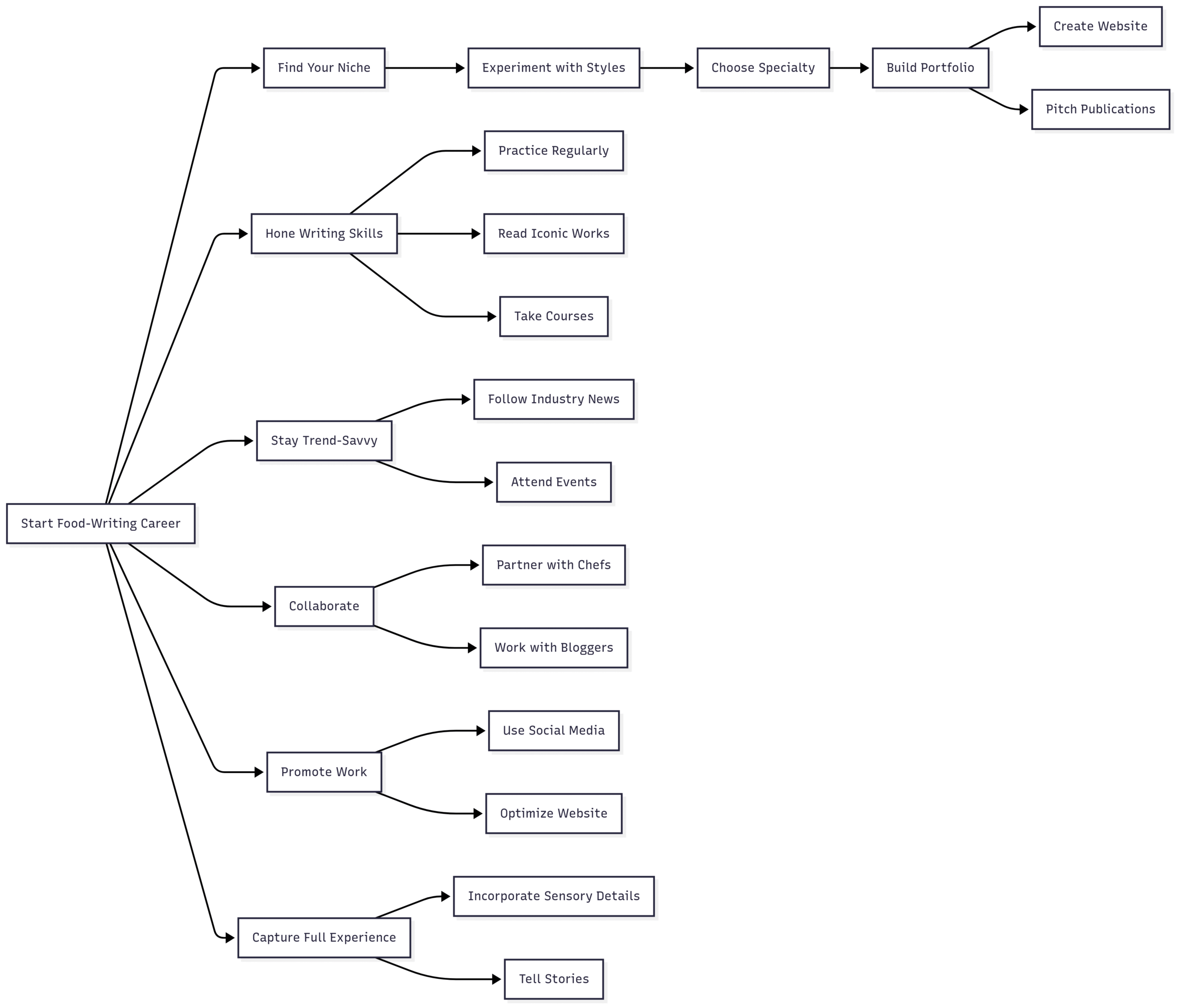7 Tasty Tips to Kickstart Your Food-Writing Career
Discover 7 expert tips to launch your food-writing career, from finding your niche to mastering storytelling and promoting your work effectively.
Food writing is a vibrant and competitive field that blends creativity, sensory exploration, and storytelling. Whether you’re describing the sizzling aroma of a freshly baked dish, the cultural history behind a local delicacy, or the ambiance of a bustling restaurant, food writing captures the essence of culinary experiences in ways that resonate with readers. For aspiring food writers, breaking into this flavorful industry requires more than just a love for food—it demands strategy, skill, and persistence. This comprehensive guide outlines seven actionable tips to help you launch a successful food-writing career, offering practical advice, industry insights, and tools to stand out in a crowded market.
Why Food Writing?
Food writing is unique in its ability to engage all the senses, weaving narratives that connect readers to cultures, memories, and emotions through the universal language of food. From restaurant reviews to cookbooks, food memoirs to travel blogs, the genre offers diverse opportunities to explore your passion for cuisine and storytelling. However, with popularity comes competition. To succeed, you need to carve out a distinct voice, build a robust portfolio, and master the art of pitching and promotion. Below, we dive into seven essential tips to help you navigate this delicious career path.
Tip 1: Discover Your Food-Writing Niche
The world of food writing is vast, encompassing various styles and formats. Finding your niche is the first step to establishing yourself as a credible and recognizable voice in the industry. A niche allows you to focus your expertise, differentiate yourself from competitors, and attract a dedicated audience.
Exploring Food-Writing Styles
Here are some popular food-writing niches to consider:
- Restaurant Reviews: This style involves critiquing the dining experience, including food quality, service, and ambiance. Reviewers must balance objectivity with vivid descriptions to guide readers effectively. For example, a review might detail the velvety texture of a chocolate mousse or the warm hospitality of a family-owned bistro.
- Culinary Journalism: This niche focuses on in-depth reporting on food-related topics, such as sustainability, food trends, or cultural influences. Articles often blend research and storytelling, like exploring the rise of plant-based diets or the impact of urban farming.
- Food Blogs: Food blogs are personal and conversational, covering recipes, cooking tips, and culinary experiences. Bloggers often use vibrant visuals and relatable anecdotes to engage readers. Successful blogs like Minimalist Baker focus on simple, accessible recipes, while Cookie + Kate emphasizes wholesome ingredients.
- Cookbook Writing: Cookbooks provide detailed recipes organized by categories like appetizers or desserts. They often include cooking tips, ingredient substitutions, and cultural context. Digital cookbooks have surged in popularity, offering interactive formats for modern audiences.
- Food Memoirs: These autobiographical works center on personal experiences tied to food, such as childhood memories or cultural traditions. Iconic examples include Kitchen Confidential by Anthony Bourdain, which blends gritty storytelling with culinary insights.
- Food Travel Writing: This niche explores global cuisines, local markets, and dining experiences through a travel lens. Writers might describe the tangy street food of Bangkok or the rustic charm of an Italian vineyard.
How to Choose Your Niche
To find your niche, reflect on your passions and expertise. Are you drawn to the storytelling of food memoirs or the analytical nature of restaurant reviews? Do you enjoy researching food trends or sharing personal recipes? Experiment with different styles by writing sample pieces or pitching ideas to publications. Over time, focus on the area that excites you most and aligns with your skills.
Benefits of Specialization
Specializing in a niche helps you:
- Build expertise and credibility.
- Attract a loyal audience interested in your focus area.
- Stand out in a competitive market.
For example, a writer specializing in sustainable food practices might become a go-to voice for eco-conscious publications, while a food travel writer could gain recognition for vivid accounts of global cuisines.
Tip 2: Hone Your Writing Craft
Exceptional writing is the backbone of a successful food-writing career. While a passion for food is essential, your ability to craft compelling, sensory-rich narratives sets you apart. Here’s how to sharpen your skills:
Practice Consistently
Writing is a muscle that strengthens with use. Commit to writing regularly, whether through a personal blog, journal, or guest articles for publications. Set a goal to write daily or weekly, experimenting with different formats and tones. For instance, try describing a simple dish like a grilled cheese sandwich in a way that evokes its golden crust and gooey center.
Develop a Unique Voice
Your voice is your signature. Experiment with styles—playful, poetic, or journalistic—to find what feels authentic. Authenticity resonates with readers, whether you’re sharing a personal anecdote about your grandmother’s soup recipe or analyzing a restaurant’s ambiance. Avoid mimicking others; instead, let your personality shine through your words.
Engage All Senses
Food writing thrives on sensory details. Beyond taste, describe the aroma of freshly baked bread, the vibrant colors of a summer salad, or the satisfying crunch of a crispy taco. For example:
The pasta arrived, its glossy sauce clinging to each twirl, releasing a warm, garlicky aroma that promised comfort with every bite.
Tell Compelling Stories
Great food writing goes beyond description—it tells a story. Weave narratives about a dish’s cultural origins, the chef’s inspiration, or your personal connection to the meal. For instance, a piece about sushi might explore its historical roots in Japan or your first experience at a sushi bar.
Resources for Improvement
- Read Widely: Study iconic food literature like The Omnivore’s Dilemma by Michael Pollan or The Gastronomical Me by M.F.K. Fisher to understand diverse styles and techniques.
- Take Courses: Enroll in food-writing courses from platforms like Coursera, MasterClass, or Gotham Writers Workshop. These provide structured learning, feedback, and networking opportunities.
- Join Writing Groups: Connect with other writers to share drafts and receive constructive feedback.
Tip 3: Build a Strong Portfolio
A portfolio showcases your best work and demonstrates your versatility to editors and clients. It’s your ticket to landing paid gigs and building credibility.
Creating Your Portfolio
- Select Your Best Work: Include a variety of pieces, such as a restaurant review, a recipe post, and a culinary article. Highlight your niche while showing range.
- Start a Website: A personal website serves as a professional hub for your work. Platforms like WordPress or Squarespace make it easy to create a polished site.
- Pitch to Publications: Submit articles to food magazines, newspapers, or online platforms like Eater or Serious Eats. Even unpaid guest posts can boost your visibility.
Optimizing Your Portfolio
- Organize Content: Group your work by category (e.g., reviews, recipes, features) for easy navigation.
- Include Visuals: High-quality images enhance food writing, especially for blogs and recipes. Invest in basic photography skills or collaborate with a photographer.
- Update Regularly: Add new pieces to keep your portfolio fresh and relevant.
Example Portfolio Structure
| Section | Content Example |
|---|---|
| Restaurant Reviews | Review of a local farm-to-table eatery |
| Recipes | Step-by-step guide to a vegan curry |
| Features | Article on the rise of fermentation trends |
| Food Travel | Narrative on exploring Moroccan spice markets |
Tip 4: Stay Ahead of Food Trends
Writing about emerging food trends keeps your content fresh and relevant. New restaurants, cooking techniques, or dietary movements offer untapped opportunities to attract readers and editors.
Identifying Trends
- Follow Industry News: Subscribe to publications like Bon Appétit, Food & Wine, or The Kitchn to stay informed.
- Monitor Social Media: Platforms like Instagram and X highlight trending dishes and cuisines through hashtags and influencer posts.
- Attend Events: Food festivals, farmers’ markets, and industry conferences reveal cutting-edge trends.
Writing About Trends
When covering trends, provide context to avoid misrepresentation. For example, if writing about the popularity of kimchi, acknowledge its Korean origins and consult credible sources like chefs or cultural experts. This ensures authenticity and respects the dish’s heritage.
Example Trend Analysis
| Trend | Description | Writing Opportunity |
|---|---|---|
| Plant-Based Diets | Growing demand for vegan/vegetarian options | Article on innovative plant-based recipes |
| Hyper-Local Ingredients | Focus on locally sourced produce | Feature on farm-to-table restaurants |
| Fermented Foods | Rising popularity of kombucha, kimchi | Guide to home fermentation techniques |
Tip 5: Collaborate with Industry Professionals
Collaboration opens doors to new insights, audiences, and opportunities. Partnering with chefs, bloggers, or food producers enriches your writing and expands your network.
Collaboration Ideas
- Chefs and Restaurateurs: Interview chefs for behind-the-scenes stories or exclusive recipes. For example, a chef might share the inspiration behind a signature dish, adding depth to your article.
- Food Bloggers and Influencers: Guest post on popular blogs or co-create content with influencers to reach new readers.
- Food Producers and Farmers: Visit farms or producers to learn about ingredient sourcing and sustainability. This is especially valuable for writers focusing on ethical food practices.
- Food Brands: Partner with brands for sponsored content or product reviews. Always disclose sponsorships to maintain transparency.
Benefits of Collaboration
- Enhanced Credibility: Insights from experts add authority to your work.
- Wider Reach: Collaborations expose your writing to new audiences.
- Monetization Opportunities: Sponsored content and affiliate links can generate income.
Tip 6: Capture the Full Experience
Food writing is about more than the dish—it’s about the entire experience. Rich details about ambiance, culture, and personal connections make your work memorable.
Elements to Include
- Sensory Details: Describe the sights, sounds, and smells of the setting. For example, a restaurant review might note the clinking of glasses or the glow of candlelight.
- Cultural Context: Explore the dish’s origins or significance. A piece on tacos might discuss their evolution in Mexican street food culture.
- Personal Anecdotes: Share your connection to the food, like a childhood memory of baking with family.
- Broader Narrative: For travel writing, tie the food to the destination’s culture or history.
Storytelling Techniques
Use a narrative structure with a clear beginning, middle, and end. For example:
- Opening: Set the scene with a vivid description of the dining environment.
- Body: Detail the food, preparation, and cultural significance.
- Conclusion: Reflect on the experience’s emotional or cultural impact.
Tip 7: Promote Your Work Effectively
Self-promotion is critical to building a food-writing career. A strategic approach amplifies your reach and attracts opportunities.
Create a Website
A professional website is your digital home base. Use it to:
- Showcase your portfolio.
- Share recipes or articles.
- Establish your brand with consistent visuals and tone.
For food bloggers, tools like the WP Recipe Maker plugin enhance website functionality. Key features include:
- Customizable Recipe Cards: Create visually appealing, SEO-friendly recipe templates.
- Taxonomy Organization: Sort recipes by cuisine, course, or difficulty for easy navigation.
- Monetization Options: Add affiliate links for ingredients or equipment.
- Social Sharing: Include buttons to encourage readers to share recipes on social media.
WP Recipe Maker Pricing (as of current data):
| Plan | Price (USD) | Features |
|---|---|---|
| Free | $0 | Basic recipe card functionality |
| Premium | $49/year | Advanced templates, SEO tools |
| Elite | $99/year | Additional features like video support |
A 30-day money-back guarantee makes it risk-free to try.
Leverage Social Media
Social media platforms like Instagram, X, and Pinterest are ideal for promoting food writing. Tips for success:
- Post Engaging Content: Share high-quality images, short videos, or trending recipes.
- Use Hashtags: Tags like #Foodie or #RecipeIdeas increase discoverability.
- Engage with Followers: Respond to comments and join food-related conversations.
Network and Pitch
- Pitch Publications: Tailor pitches to the publication’s audience and style. For example, pitch a trend-focused article to Eater or a recipe to Food52.
- Attend Industry Events: Food festivals and writing conferences offer networking opportunities.
- Join Online Communities: Participate in forums or groups like Food Bloggers Central to connect with peers.
Chart: Food-Writing Career Roadmap

Additional Tips from a Seasoned Food Writer
Drawing from years of experience, here are ten bonus tips to elevate your food writing:
- Engage All Senses: Describe the dish’s texture, aroma, and presentation to immerse readers.
- Expand Your Vocabulary: Use diverse descriptors like “buttery” or “zesty” instead of overused terms like “tasty.”
- Tell a Story: Share the dish’s cultural or personal significance to create a narrative arc.
- Educate and Entertain: Explain techniques or ingredients while keeping the tone engaging.
- Evoke Nostalgia: Connect with readers by referencing shared food memories.
- Use Quotes: Include insights from chefs or experts to add authenticity.
- Structure Your Piece: Follow a clear outline with a compelling intro, detailed body, and strong conclusion.
- Edit Ruthlessly: Remove unnecessary words to keep your writing concise.
- Talk It Out: Verbalize your experience to capture natural, vivid descriptions.
- Read Widely: Study credible food writing to refine your craft.
Conclusion
Launching a food-writing career is a journey of passion, creativity, and strategy. By finding your niche, honing your skills, building a portfolio, staying trend-savvy, collaborating with others, capturing the full experience, and promoting your work, you can carve out a successful path in this competitive field. Tools like WP Recipe Maker can enhance your online presence, while persistence and storytelling will set your work apart. Let your words be the spice that flavors the world of food literature, and embark on this delicious adventure with confidence.
Please share these 7 Tasty Tips to Kickstart Your Food-Writing Career with your friends and do a comment below about your feedback.
We will meet you on next article.
Until you can read, Parmesan-Crusted Air Fryer Asparagus






